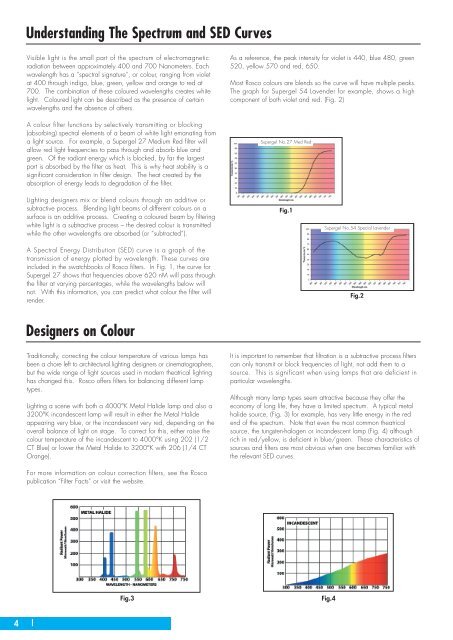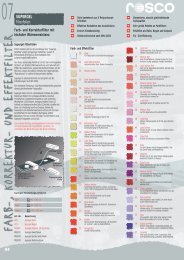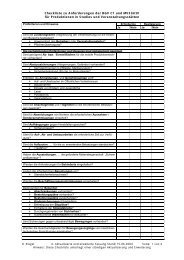Lighting the Acting Areas - AudioMaster
Lighting the Acting Areas - AudioMaster
Lighting the Acting Areas - AudioMaster
You also want an ePaper? Increase the reach of your titles
YUMPU automatically turns print PDFs into web optimized ePapers that Google loves.
4<br />
Understanding The Spectrum and SED Curves<br />
Visible light is <strong>the</strong> small part of <strong>the</strong> spectrum of electromagnetic<br />
radiation between approximately 400 and 700 Nanometers. Each<br />
wavelength has a “spectral signature”, or colour, ranging from violet<br />
at 400 through indigo, blue, green, yellow and orange to red at<br />
700. The combination of <strong>the</strong>se coloured wavelengths creates white<br />
light. Coloured light can be described as <strong>the</strong> presence of certain<br />
wavelengths and <strong>the</strong> absence of o<strong>the</strong>rs.<br />
A colour filter functions by selectively transmitting or blocking<br />
(absorbing) spectral elements of a beam of white light emanating from<br />
a light source. For example, a Supergel 27 Medium Red filter will<br />
allow red light frequencies to pass through and absorb blue and<br />
green. Of <strong>the</strong> radiant energy which is blocked, by far <strong>the</strong> largest<br />
part is absorbed by <strong>the</strong> filter as heat. This is why heat stability is a<br />
significant consideration in filter design. The heat created by <strong>the</strong><br />
absorption of energy leads to degradation of <strong>the</strong> filter.<br />
<strong>Lighting</strong> designers mix or blend colours through an additive or<br />
subtractive process. Blending light beams of different colours on a<br />
surface is an additive process. Creating a coloured beam by filtering<br />
white light is a subtractive process – <strong>the</strong> desired colour is transmitted<br />
while <strong>the</strong> o<strong>the</strong>r wavelengths are absorbed (or “subtracted”).<br />
A Spectral Energy Distribution (SED) curve is a graph of <strong>the</strong><br />
transmission of energy plotted by wavelength. These curves are<br />
included in <strong>the</strong> swatchbooks of Rosco filters. In Fig. 1, <strong>the</strong> curve for<br />
Supergel 27 shows that frequencies above 620 nM will pass through<br />
<strong>the</strong> filter at varying percentages, while <strong>the</strong> wavelengths below will<br />
not. With this information, you can predict what colour <strong>the</strong> filter will<br />
render.<br />
Designers on Colour<br />
Traditionally, correcting <strong>the</strong> colour temperature of various lamps has<br />
been a chore left to architectural lighting designers or cinematographers,<br />
but <strong>the</strong> wide range of light sources used in modern <strong>the</strong>atrical lighting<br />
has changed this. Rosco offers filters for balancing different lamp<br />
types.<br />
<strong>Lighting</strong> a scene with both a 4000°K Metal Halide lamp and also a<br />
3200°K incandescent lamp will result in ei<strong>the</strong>r <strong>the</strong> Metal Halide<br />
appearing very blue, or <strong>the</strong> incandescent very red, depending on <strong>the</strong><br />
overall balance of light on stage. To correct for this, ei<strong>the</strong>r raise <strong>the</strong><br />
colour temperature of <strong>the</strong> incandescent to 4000°K using 202 (1/2<br />
CT Blue) or lower <strong>the</strong> Metal Halide to 3200°K with 206 (1/4 CT<br />
Orange).<br />
For more information on colour correction filters, see <strong>the</strong> Rosco<br />
publication “Filter Facts” or visit <strong>the</strong> website.<br />
|<br />
WARM FILTERS<br />
Fig.3<br />
As a reference, <strong>the</strong> peak intensity for violet is 440, blue 480, green<br />
520, yellow 570 and red, 650.<br />
Most Rosco colours are blends so <strong>the</strong> curve will have multiple peaks.<br />
The graph for Supergel 54 Lavender for example, shows a high<br />
component of both violet and red. (Fig. 2)<br />
Supergel No.27 Med Red<br />
Fig.1<br />
Supergel No.54 Special Lavender<br />
Fig.4<br />
Fig.2<br />
It is important to remember that filtration is a subtractive process filters<br />
can only transmit or block frequencies of light, not add <strong>the</strong>m to a<br />
source. This is significant when using lamps that are deficient in<br />
particular wavelengths.<br />
Although many lamp types seem attractive because <strong>the</strong>y offer <strong>the</strong><br />
economy of long life, <strong>the</strong>y have a limited spectrum. A typical metal<br />
halide source, (Fig. 3) for example, has very little energy in <strong>the</strong> red<br />
end of <strong>the</strong> spectrum. Note that even <strong>the</strong> most common <strong>the</strong>atrical<br />
source, <strong>the</strong> tungsten-halogen or incandescent lamp (Fig. 4) although<br />
rich in red/yellow, is deficient in blue/green. These characteristics of<br />
sources and filters are most obvious when one becomes familiar with<br />
<strong>the</strong> relevant SED curves.






